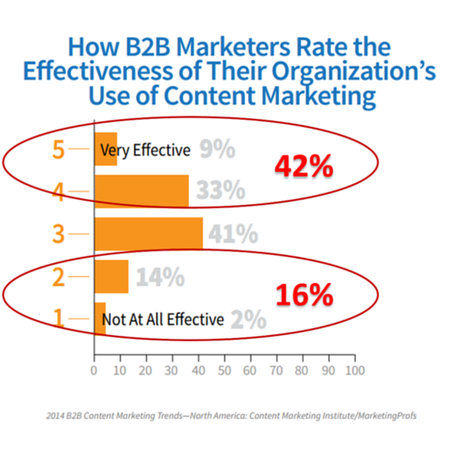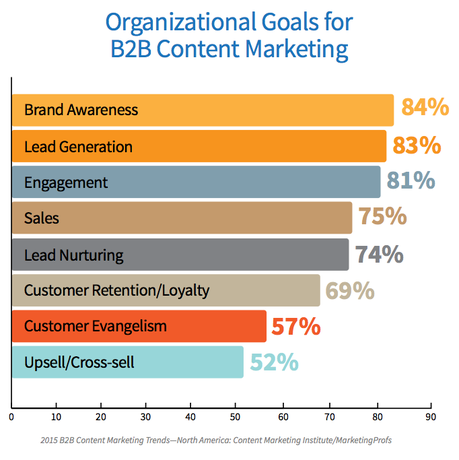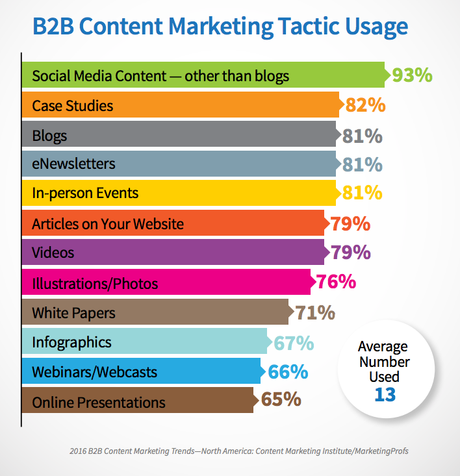
Sweet marketing techniques turn sour when quantity overwhelms quality. Pop-up ads were a good idea until they started popping up everywhere. Likewise, email has become difficult to pull off because spammers have throttled it: spam now represents almost 57 percent of worldwide email traffic!

The same thing is happening in content marketing. In 2014, Mark Schaefer famously wrote about content shock, which in his words, is occurring because "exponentially increasing volumes of content intersect our limited human capacity to consume it." If you think your content will get noticed, consider the competition.
With so much content competing for attention, how can a B2B organization's content get noticed? Even more important, how can its content generate significant, measurable results? Here are three common mistakes that completely undermine content marketing in the B2B world. Avoid these errors and you actually stand a great chance of success.
Mistake 1: Shotguns Aimed at the Wrong Targets
You would think a company launching a blog or Facebook page because everyone else is doing it is rather flimsy reasoning. At our agency, where we've talked to prospective B2B clients day in and day out since the early '00s, this is exactly what happens all the time. Companies cannot resist chasing the new, shiny object out of fear of falling behind the competition or missing out on a magic marketing bullet (which doesn't exist, by the way).
The first thing a B2B needs to figure out, before spending a dime creating content, is to figure out where the target audience is, and where it will pay attention to your message. Are your prospects hanging around on Twitter or Facebook all day? Possibly not. Are they interested in talking about HVAC systems or industrial packaging on Twitter or Facebook? Probably not.
On the other hand, B2B prospects certainly use email. Thus, they may have interest in subscribing to a newsletter or blog, under the right circumstances. They may be interested in consuming content on LinkedIn, under the right circumstances. They may even be receptive to consuming content on Twitter, Facebook and other social channels, under the right circumstances.
What are the right circumstances? The right circumstances are you, the publisher, building a community that is engaged and has a shared interest.

If you can build such a community, your followers will read, share and hopefully act on (see #2) your content, generating sales leads, brand awareness or whatever other goals you have for your content marketing campaign. Instead of producing "shotgun" content covering 1,000 topics, you will produce "rifle" content zeroed in on the aspects of your company, products, services and industry that matter to your targeted audience.
If you can't build such a community, fold the tent. Move to another channel. There's no value in producing content for an indifferent audience. All it does is drain your valuable marketing resources.
Mistake 2: No Conversion Message
Along with creating highly relevant and useful content for an engaged audience, it's imperative for content to have effective conversion messaging. Winding up a blog post with a halfhearted, "Call to learn more" is not an effective conversion message, and yet something like this is exactly what many B2Bs do with respect to all of their on-site and off-site marketing content. If this is what you are doing:
If your primary or secondary goal of content marketing is to generate leads, then you have to persuade readers to act on your content after they have consumed it. This is the essence of the content marketing "give-to-get" philosophy. The value proposition of your marketing content is as follows:
Our company will share its knowledge free of charge, helping you improve your business. In exchange, we'd like an opportunity to work with you as a supplier.Readers need to be hit over the head with this. As any B2B sales rep knows, you have to ask for the order. It amazes me how few B2Bs with terrific sales teams fail to apply this simple communication principle to their content marketing. Without a strong "ask," your "give-to-get" content becomes "give-to-get-nothing" content. Not sustainable! To secure leads and referrals, send messages such as:
- Become a participant in our beta test.
- Get a 30-day, free, on-site trial of our equipment.
- Call for a free, no-strings-attached on-site audit.
- Get 25 percent off all purchases for next 30 days.
- Refer a customer and receive a $500 credit.
- For all of your purchases in [month] we'll donate 2 percent to [charity].
- Join our webinar to learn about [x], the hottest topic in [industry].
- Download our case study now to learn how to increase throughput 25 percent.
These are ways to get B2B buyers and influencers thinking about doing business with you. Take a look at your marketing content. Are messages like these present and noticeable? If not, you are missing opportunities to generate content marketing ROI.

Mistake 3: Conversion Unfriendly Content
In addition to having a specific conversion message - maybe more than one - the rest of the content must be conversion friendly. A great deal of B2B content is anything but conversion friendly.
Jargon
One of the world's leading experts in content, David Meerman Scott, issued his Gobbledygook Manifesto in 2006, a full frontal attack on jargon-littered business content. B2Bs are gross offenders, often sprinkling tech-speak and catch phrases throughout their content, rendering it incomprehensible. In an effort to look smart, such a B2B drives away potential leads and brand advocates.
Inward Focus
Another serious flaw in B2B content is writing about what matters to employees and stakeholders rather than what matters to prospects and customers. "Inside-the-box thinking" is so ingrained with B2Bs that they are generally not even aware they are writing this perspective into their content.
B2Bs love to talk about their history, their innovation, their unique designs, their patents, their product specifications, their fantastic work environments, their terrific safety records, etc., etc., etc. The usual reaction from prospects and customers:
B2B buyers and influencers are under heavy pressure to solve problems, improve results, and fend off competitors. They are also swimming through an ocean of content to find solutions. If your content doesn't provide them and make it obvious within seconds, they're off to look elsewhere.

Less Is More
The common theme here - and the good news for B2Bs - is less content marketing is better than more content marketing.
- Aim at a small target audience, but make sure it's the right audience.
- Don't write about everything, just about the things that matter to the audience.
- Replace big words with little words, and overly complex ideas with simpler ones.
In marketing, "more" is often confused with "better." Start small and be great - you can always produce more content when you start seeing results.
Author Bio:
